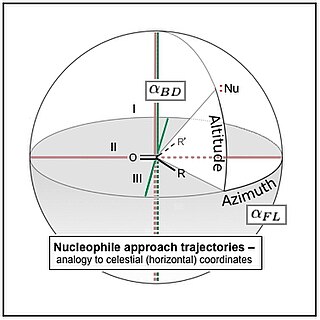In organic chemistry, the Swern oxidation, named after Daniel Swern, is a chemical reaction whereby a primary or secondary alcohol is oxidized to an aldehyde or ketone using oxalyl chloride, dimethyl sulfoxide (DMSO) and an organic base, such as triethylamine. It is one of the many oxidation reactions commonly referred to as 'activated DMSO' oxidations. The reaction is known for its mild character and wide tolerance of functional groups.

In chemistry, pi bonds are covalent chemical bonds, in each of which two lobes of an orbital on one atom overlap with two lobes of an orbital on another atom, and in which this overlap occurs laterally. Each of these atomic orbitals has an electron density of zero at a shared nodal plane that passes through the two bonded nuclei. This plane also is a nodal plane for the molecular orbital of the pi bond. Pi bonds can form in double and triple bonds but do not form in single bonds in most cases.

Propyne (methylacetylene) is an alkyne with the chemical formula CH3C≡CH. It is a component of MAPD gas—along with its isomer propadiene (allene), which was commonly used in gas welding. Unlike acetylene, propyne can be safely condensed.
Rigvedic deities are deities mentioned in the sacred texts of Rigveda, the principal text of the historical Vedic religion of the Vedic period.
Phenylhydrazine is the chemical compound with the formula C6H5NHNH2. It is often abbreviated as PhNHNH2. It is also found in edible mushrooms.
Clayton Heathcock is an organic chemist, Professor of Chemistry, and Dean of the College of Chemistry at the University of California, Berkeley. Professor Heathcock is well known for his accomplishments in the synthesis of complex polycyclic natural products and for his contributions to the chemistry community. In 1995 he became a member of the National Academy of Sciences.

The Bürgi–Dunitz angle is one of two angles that fully define the geometry of "attack" of a nucleophile on a trigonal unsaturated center in a molecule, originally the carbonyl center in an organic ketone, but now extending to aldehyde, ester, and amide carbonyls, and to alkenes (olefins) as well. The angle was named after crystallographers Hans-Beat Bürgi and Jack D. Dunitz, its first senior investigators.

The Flippin–Lodge angle is one of two angles used by organic and biological chemists studying the relationship between a molecule's chemical structure and ways that it reacts, for reactions involving "attack" of an electron-rich reacting species, the nucleophile, on an electron-poor reacting species, the electrophile. Specifically, the angles—the Bürgi–Dunitz, , and the Flippin–Lodge, —describe the "trajectory" or "angle of attack" of the nucleophile as it approaches the electrophile, in particular when the latter is planar in shape. This is called a nucleophilic addition reaction and it plays a central role in the biological chemistry taking place in many biosyntheses in nature, and is a central "tool" in the reaction toolkit of modern organic chemistry, e.g., to construct new molecules such as pharmaceuticals. Theory and use of these angles falls into the areas of synthetic and physical organic chemistry, which deals with chemical structure and reaction mechanism, and within a sub-specialty called structure correlation.
Heathcock Peak is a peak, 2,310 metres (7,580 ft) high, located in the eastern part of the Caloplaca Hills in Antarctica and overlooking the western edge of Reedy Glacier. It was mapped by the United States Geological Survey from surveys and U.S. Navy air photos, 1960–64, and was named by the Advisory Committee on Antarctic Names for Joe D. Heathcock, a U.S. Navy Seabee, stationed at Byrd Station in 1962.
Andrew Streitwieser was an American chemist known for his contributions to physical organic chemistry.

Ronald Jeffrey "Jeff" Heathcock is a former Major League Baseball pitcher. Heathcock played for the Houston Astros for four years, 1983, 1985, 1987, and 1988.
Hathcock is a surname. Notable people with the surname include:

Ekaterina Avramova is a Bulgarian-born swimmer competing for Turkey.

Alan Heathcock is an American fiction writer. He grew up in the Chicago suburb of Hazel Crest, Illinois and attended the University of Iowa, where he graduated in 1993 with a BA in Journalism. Heathcock earned MFAs from both Bowling Green State University (1996), and Boise State University (2003). He lives in Boise, Idaho.

The City of Southampton Swimming Club is the major swimming club in Southampton, Hampshire in the United Kingdom and is currently based at The Quays Swimming & Diving Complex near West Quay.
Biomimetic synthesis is an area of organic chemical synthesis that is specifically biologically inspired. The term encompasses both the testing of a "biogenetic hypothesis" through execution of a series of reactions designed to parallel the proposed biosynthesis, as well as programs of study where a synthetic reaction or reactions aimed at a desired synthetic goal are designed to mimic one or more known enzymic transformations of an established biosynthetic pathway. The earliest generally cited example of a biomimetic synthesis is Sir Robert Robinson's organic synthesis of the alkaloid tropinone.
Amadeus Serafini is a British-born American actor. He is known for his role as Kieran Wilcox in the first two seasons of MTV's slasher series Scream.
Ruth Sabina Heathcock BEM was an award-winning remote area nurse in the Northern Territory of Australia who specialised in the treatment of leprosy. She received an Order of the British Empire for rowing 145 kilometres to save a man who accidentally shot himself.
Anna Kathryn Mapp is an American chemist and the Edwin Vedejs collegiate professor of Chemistry. In 2013, Mapp joined the Michigan Life Sciences Institute as a research professor. Mapp served as the Director of the Program in Chemical Biology at the University of Michigan until 2019 when she accepted a position as the Associate Dean for Academic Programs and Initiatives at the University of Michigan Rackham graduate school.







